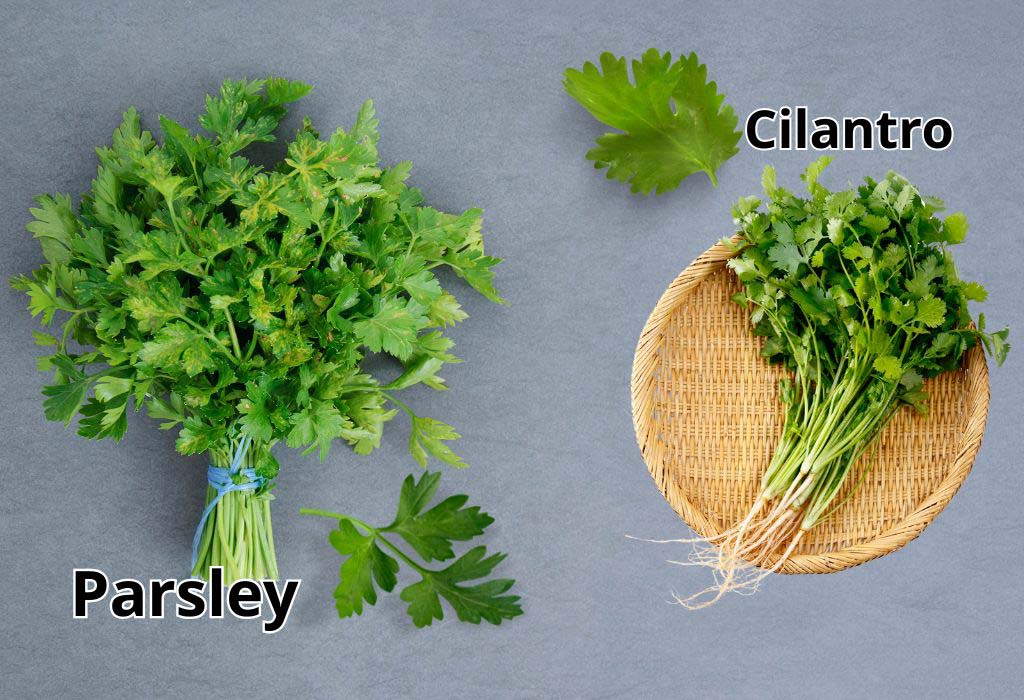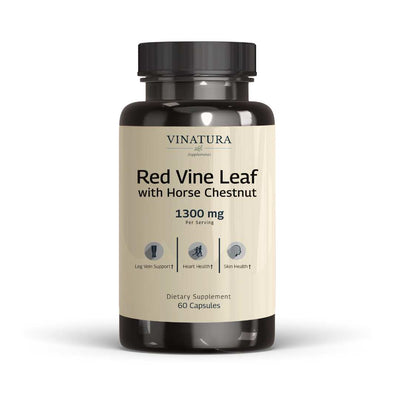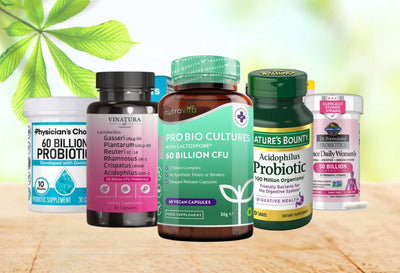
Parsley vs Cilantro: Key Differences, Uses, and Health Benefits
Parsley and cilantro are two popular green herbs that are often confused due to their similar appearance. However, they differ greatly in flavor, uses, and health benefits.
More and more people are turning to herbs not just for culinary enhancement but also for their health-promoting properties – especially for detox and internal deodorizing. This article will help you clearly distinguish between parsley and cilantro and choose the right one based on your personal needs.
Before exploring further, please read the disclaimer located at the end of this webpage.
Key Takeaways
- Parsley and cilantro are often confused but differ in flavor, aroma, culinary uses, and health benefits.
- Parsley is rich in chlorophyll, supports body odor control, and is ideal for mild flavor dishes.
- Cilantro offers bold flavor, supports digestion and detox, and may help reduce internal odor.
- Both herbs contain antioxidants and antibacterial compounds that contribute to overall freshness.
- For best results, rotate or combine both in meals, smoothies, or teas to maximize their complementary effects.
Parsley vs Cilantro: Quick Comparison Table
|
Feature |
Parsley (Petroselinum crispum) |
Cilantro (Coriandrum sativum) |
|
Scientific Name |
Petroselinum crispum |
Coriandrum sativum |
|
Plant Family |
Apiaceae (Carrot family) |
Apiaceae (Carrot family) |
|
Leaf Shape |
Tripinnate leaves, usually pointed; can be flat or curly depending on the variety |
Fan-shaped leaves with rounded tips and pronounced veins; broader at the base, tapering toward the tip |
|
Flavor & Aroma |
Fresh, mild, and slightly herbal; subtle lemony note |
Strong, pungent, slightly sour; very aromatic — some people perceive a "soapy" taste due to genetic variation |
|
Culinary Uses |
Common in European, American, and Middle Eastern cuisines. Used as garnish or seasoning in soups, salads, fish, etc. Curly parsley is for decoration; flat-leaf parsley is preferred for cooking. |
Widely used in Mexican, Indian, Southeast Asian dishes. Fresh leaves added at end of cooking (soups, curries, salsas). Dried seeds (coriander) are used as spice in curries, sauces, pickles. |
|
Nutritional Value |
Rich in vitamins K, A, C; high in antioxidants. Very low in calories but dense in calcium, iron, etc. |
Rich in vitamins A, C, K and minerals like iron, potassium. Contains antioxidants (flavonoids, vitamin C) and phytonutrients |
|
Health Benefits |
– Supports bone and blood health (vitamin K)– Enhances immunity (vitamin A, C)– Aids digestion (reduces bloating) |
– Rich in antioxidants– May support blood sugar & heart health (needs more research)– Aids digestion, may help detox |
|
Substitution Potential |
Can replace cilantro in some dishes (e.g., salmon, potatoes), but milder and less distinctive in flavor |
Can replace parsley in Mexican or Asian dishes, but flavor is stronger. Often unsuitable for Western dishes due to bold aroma |
|
Usage Tips |
– Use fresh for best flavor; dried form less aromatic– Limit large quantities during pregnancy (apiole)– Refrigerate and rinse before use |
– Always use fresh and add at end of cooking– Rinse well to remove debris– 4–14% of people have a gene making cilantro taste "soapy"; parsley or other herbs can be used instead if disliked |
Taste and Aroma: Why They’re Often Confused
Parsley and cilantro are often mistaken for each other due to their similar leaf shapes and the fact that both belong to the Apiaceae family. Additionally, their names and culinary uses can be confusing—especially for those unfamiliar with their distinctive flavors.
Parsley: Has a fresh, mildly peppery flavor with earthy undertones. Its taste brightens dishes without overpowering the main flavors. Parsley leaves are slender and pointed, and their aroma is easily recognizable when smelled.

Cilantro: Offers a strong, fresh flavor with characteristic citrusy notes. Some people describe cilantro as having a “soapy” taste due to aromatic aldehydes in the leaves, which are similar to compounds used in soaps.*
There is genetic variation in how people perceive the flavor of cilantro. While most people detect a fresh, lemony aroma, about 4%–14% report a soapy taste (Singletary, 2016).
This difference in perception is genetic: people with a variation in the OR6A2 olfactory receptor gene are more sensitive to aldehydes in cilantro, which creates the unpleasant “soapy” sensation.
“Scientists found most coriander haters to have a common olfactory receptor gene called OR6A2, which absorbs the odour of aldehyde chemicals.”
- Eriksson et al., (2012). A genetic variant near olfactory receptor genes influences cilantro preference [2].
Tip for distinguishing: Instead of smelling a fresh sprig directly, try gently crushing a few leaves of the herb before smelling. The texture and aroma of cilantro and parsley become more pronounced when the leaves are bruised.
Many people believe that crushing cilantro leaves helps release their natural fragrance and may reduce the “soapy” taste experienced by those who are sensitive to it [3].
Culinary Uses
Parsley
How to use parsley in cooking:
- As a garnish: Often finely chopped and sprinkled over dishes after cooking.
- In bouquet garni: A herb bundle used for soups and broths.
- In sauces: A key ingredient in chimichurri, gremolata, and some pesto recipes.
- Dried form: Used during cooking, as it needs time to release flavor.
Preparation and storage tips:
- Cleaning: Soak in water and gently shake to remove soil and debris.
- Chopping: Can be chopped with or without stems.
Storage:
- Fresh: Wrap in a damp cloth, place in a sealed bag, and store in the refrigerator for 3–5 days.
- Dried: Store in a cool, dry, airtight container; use within 3–6 months.
Parsley leaves can also be blended into smoothies or vegetable juices to add a light herbal note and enhance the drink’s nutritional value (e.g., vitamins, fiber). Its mild flavor makes it ideal for people who are sensitive to stronger-tasting herbs.

Cilantro
Cilantro is a versatile herb, ideal for: Salads, salsa, chutney, pesto, sauces, dips, and salad dressings.
Featured Dishes:
- Peach and mango salsa with grilled chicken
- Guacamole with diced apples – a creative twist
- Baja fish tacos with crunchy red cabbage slaw
- Indian-style grilled and grilled tandoori chicken
- Grilled beef salad with cilantro, basil, and mint
- Hawaiian pizza with mango, pineapple, onion, chili, and fresh cilantro
Tips for Selecting and Storing
- Choose vibrant green, fragrant leaves; rinse before using.
- Store upright in a glass of water in the fridge, like keeping fresh flowers.
Freezing:
- Blanch briefly, pat dry, store flat in a zip bag.
- Or blend with olive oil and pour into an ice cube tray for easy use later.
Cooking Tips with Cilantro
- Typically used fresh, added after cooking or as garnish since heat reduces its aroma.
- In Indian and Central Asian cuisines, cilantro is sometimes cooked into dishes to build flavor complexity.
Cilantro contains essential oils and antioxidants. A useful tip: add it to smoothies or detox juices — blend with greens, apple, lemon, or ginger to support body detoxification, freshen breath, and reduce odor. Like parsley, cilantro’s essential oils have anti-inflammatory and antibacterial properties.
Health Benefits

Parsley contains chlorophyll and its derivatives, which have been studied for their antioxidant and detoxifying effects. Thanks to these properties, the chlorophyll in parsley may help neutralize body odor from within [4].
Some benefits of parsley [5]:
- Rich in vitamins and minerals
- Aids digestion: helps reduce bloating and digestive discomfort
- Acts as a diuretic: supports kidneys and urinary tract
- May regulate menstruation (based on traditional medicine)
- Has antibacterial and anti-inflammatory effects; supports respiratory health
- May promote hair growth when used topically
- Commonly used in large quantities as both herb and vegetable, especially in Middle Eastern dishes (e.g., tabbouleh)
- Parsley provides chlorophyll, which may support detox and help reduce internal odor by neutralizing odor-causing compounds [8]
Cilantro:
Cilantro seeds contain various active compounds such as linalool (60–70%), sugars, alkaloids, flavones, tannins, and fixed oils. Cilantro leaves are rich in phenolic acids such as caffeic, ferulic, gallic, and chlorogenic acids.
In traditional medicine, cilantro has been used for supporting digestive comfort and addressing symptoms associated with insomnia, anxiety, arthritis, parasitic infections, coughs, allergies, urinary discomfort, and cystitis [6].
Cilantro is also widely used in detox practices. It’s believed to "bind" to heavy metals in the body and help eliminate them. However, mainstream research has not definitively confirmed cilantro’s effectiveness in heavy metal detoxification—this remains anecdotal and lacks strong scientific validation.
Rotate or Combine for Optimal Benefits
To get the best of both worlds, consider rotating or combining parsley and cilantro in your meals. For instance, use parsley in some salads and cilantro in other dishes.
For detox, you can include both in juices or smoothies — such as a celery–parsley–ginger juice on some days, alternating with a green smoothie containing cilantro, apple, and lemon to ensure balanced nutrient intake throughout the week.
Which One Is Better for Body Odor?

Parsley excels in chlorophyll content:
Many believe that parsley helps neutralize body odor more effectively due to its high chlorophyll content. Chlorophyll in parsley (also found in spinach and celery) is thought to help “freshen” the body when consumed regularly.
For example, Vladyslava, a user in the U.S., shared her experience in an Amazon review: she was initially skeptical, but after about a week of daily parsley intake, she noticed her body odor had almost completely disappeared—even after workouts or stressful days. Previously, she had to reapply deodorant throughout the day, but now she feels fresh all day long.*
Cilantro supports digestion and detox:
Meanwhile, cilantro is known for promoting gut and liver health thanks to its antibacterial and anti-inflammatory properties. It contains digestive enzymes that enhance nutrient absorption and may indirectly reduce body odor by improving metabolism.
A simple deodorizing detox juice can include celery, apple, lemon, and a small amount of cilantro—supporting liver detox, digestion, and fresher breath. There are also supplement capsules combining parsley, cilantro, and chlorella extracts marketed as natural deodorants and detox aids.

Can You Substitute One for the Other?
In cooking:
Culinarily, the two herbs can sometimes be substituted—but not seamlessly. Due to their distinct flavors, substitution will alter the dish's taste profile.
For instance, using parsley in tacos or Mexican dishes, or cilantro in Italian sauces, would stray from traditional flavor expectations. While parsley and cilantro may look similar, “their taste and culinary applications are completely different.”
To avoid confusion, follow the specific herb listed in recipes—“cilantro” means coriander leaves, while “parsley” refers to flat-leaf or curly parsley.
For health purposes: When it comes to nutrition and wellness, each herb has its own strengths and should be used accordingly.
To support vitamin K intake, reduce water retention, or promote urination, parsley is more effective.
For detoxifying heavy metals or improving digestion, cilantro is the better choice.
In some cases, combining both herbs in your diet allows you to benefit from their unique properties. For example, parsley may be used in lunch salads while cilantro complements your evening detox smoothie.
Conclusion
Both parsley and cilantro offer a wide range of health and culinary benefits—neither is superior in every aspect. If you’re looking for a mild, versatile herb that can blend into various dishes and help with long-term body odor control, parsley is the herb to prioritize.
If your focus is on bold flavors, digestive support, or detox variety, cilantro is a great choice. Ideally, rotate or combine both in your daily meals to fully tap into the natural benefits each one offers.
Testimonial Disclaimer
*The testimonials presented on this website are provided by individuals based on their personal experiences with our products. These testimonials represent individual opinions and experiences, which may not be typical or applicable to all users of our products. Results may vary depending on a variety of factors, including individual health, lifestyle, and adherence to product usage instructions.References
- [1] Song X, Wang J, Li N, et al. Deciphering the high‐quality genome sequence of coriander that causes controversial feelings. Plant Biotechnology Journal. 2020;18(6):1444-1456. doi:https://doi.org/10.1111/pbi.13310
- [2] Eriksson, N., Wu, S., Do, C. B., Kiefer, A. K., Tung, J. Y., Mountain, J. L., Hinds, D. A., & Francke, U. (2012). A genetic variant near olfactory receptor genes influences cilantro preference. Flavour, 1(1). https://doi.org/10.1186/2044-7248-1-22
- [3] Clinic C. Love It or Hate It — The Great Cilantro Debate. Cleveland Clinic. Published October 27, 2020. Accessed June 19, 2025. https://health.clevelandclinic.org/do-you-love-or-hate-cilantro-the-reason-may-surprise-you
- [4] Martins T, Barros AN, Rosa E, Antunes L. Enhancing Health Benefits through Chlorophylls and Chlorophyll-Rich Agro-Food: A Comprehensive Review. Molecules. 2023;28(14):5344-5344. doi:https://doi.org/10.3390/molecules28145344
- [5] Drugs.com. Parsley Uses, Benefits & Side Effects. Drugs.com. Published 2025. Accessed June 13, 2025. https://www.drugs.com/npc/parsley.html
- [6] Abascal K, Yarnell E. Cilantro—Culinary Herb or Miracle Medicinal Plant? Alternative and Complementary Therapies. 2012;18(5):259-264. doi:https://doi.org/10.1089/act.2012.18507
- [7] Singletary K. Coriander: Overview of Potential Health Benefits. Nutrition Today. 2016;51(3):151-161. doi:https://doi.org/10.1097/nt.0000000000000159
- [8] Martins, T., Barros, A. N., Rosa, E., & Antunes, L. (2023). Enhancing Health Benefits through Chlorophylls and Chlorophyll-Rich Agro-Food: A Comprehensive Review. Molecules, 28(14), 5344. https://doi.org/10.3390/molecules28145344
Author

Product Disclaimer
The dietary supplement products mentioned on this website are formulated based on scientific research and adhere to FDA guidelines for dietary supplements. However, the content of the articles has not been evaluated by the Food and Drug Administration (FDA) and is not intended to promote or endorse any specific product. Any products sold on this website are not intended to diagnose, treat, cure, or prevent any disease.
Opinions and Endorsements
Any claims, statements, or opinions expressed in the articles are those of the author(s) and do not necessarily reflect the views or opinions of the manufacturers of the dietary supplement products. The products sold on this website are separate from the content of the articles and are not directly endorsed or associated with the information presented here.
Liability Disclaimer
The author(s) of the articles, website, and manufacturers of the dietary supplement products do not assume any liability for any potential consequences arising from the use of the information provided in the articles. It is recommended that individuals consult with a qualified healthcare professional before making any dietary or lifestyle changes, including the use of dietary supplements.
Product Usage
Please refer to the product labels and packaging for specific usage instructions and guidelines for the dietary supplement products sold on this website.
Customer Support
For any concerns or questions regarding the dietary supplement products, please contact our customer support team, who will be more than happy to assist you.





Leave a Comment
Be the first to comment.
What do you think?